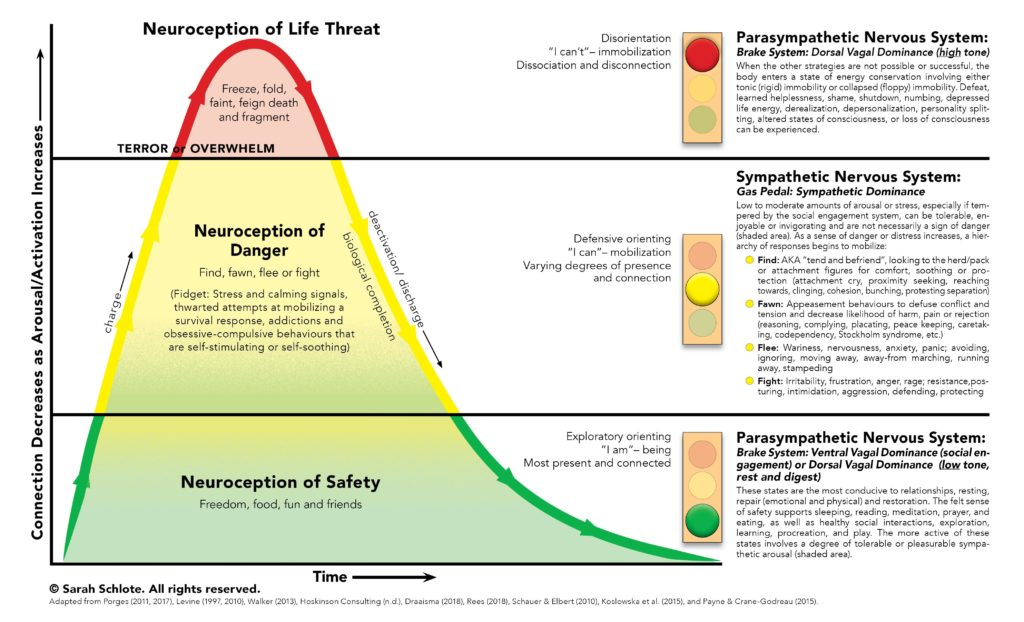We are currently experiencing a global pandemic, which is a form of collective trauma.
Most people are used to associating the word trauma with things like the horrors of war combat, or possibly sexual assault or domestic violence.
There are certain events which are likely to be traumatic no matter who experiences them. This includes physical or sexual assault, car accidents, natural disasters, etc.
What we call trauma is actually the result of what is happening inside your nervous system during the event, rather than the event itself.
Trauma happens when your nervous system gets too overwhelmed to regulate itself. Anything that is “too much, too fast” can be traumatic.
Traumatic events are situations that make you feel terrified, helpless, out of control, or fear for your life.
This is why two people can experience the same event, and once can be traumatized by it, while another is not.
Your Nervous System
This video is a great brief introduction to the human nervous system, which is actually divided into parts. There is the somatic nervous system, and the autonomic nervous system. The autonomic nervous system controls bodily functions like breathing, circulation, digestion, etc. It operates on the subconscious level, and responds to perceived threats in your environment.
It is divided into both sympathetic and parasympathetic branches. The part of the nervous system most closely related to trauma is the sympathetic nervous system.
The sympathetic nervous system has evolved and adapted over generations. It constantly assesses for threats. This means it can respond quickly to pump us full of adrenaline and other hormones. This helps us react quickly, which keeps us alive.
Fight or Flight and Freeze
Most people are likely familiar with what is commonly called the “fight or flight” response.
This response is present in all mammals. It was most beneficial when humans were nomadic hunter-gatherers. If you are hunting and start to be chased by a bear or mammoth, your first instinct will likely be to run away. Or, if you are cornered, you might go on the attack to protect and defend yourself.
The trouble is, right now we’re not being chased or attacked by a threat we can see. A lot of modern threats create constant, low-level stress. This is not the environment our nervous system evolved to be in.
We know we’re in danger from COVID-19. But we are being asked to do the exact opposite of what our bodies want to do in a stressful situation – sit at home.
The above graphic is a pretty good illustration of the fight/flight/freeze stress responses and their impact on our bodies. Everyone has a range of stress their body can handle. When stress gets too high, your body might get overwhelmed and shut down. This is the “freeze” response.
Freeze is a concept people might be less familiar with. If you can’t run away from the bear, and you can’t fight back, you will freeze and collapse. Think of what happens to a mouse being chased by a cat. It’s also where we get the phrase “playing possum.” If the threat thinks you are dead already, it might leave you alone.
How to Release Stress
Your body has sensed a threat, and your nervous system is likely activated as a result.
You might feel restless, anxious, be having trouble sleeping. You might feel irritable, or experience digestive issues or feel tightness in your chest. But there isn’t anything you can *do* to get away from this threat except stay inside.
So what now?
Move Your Body
One possible coping mechanism is physical activity. Move your body. Lean into the fact that your body is in fight or flight mode. Go for a walk or a jog. Put on your favorite song and dance. Stomp your feet. Shake your arms. Scream if you can, it’s cathartic. (Just warn your roommates, or better yet, have them join in!)
Repetitive Motions
This is also why people are baking bread. Knead some dough. Dig in the garden. Pull some weeds. Chop vegetables. Fill an empty gallon jug with water and use it as a weight. Do jumping jacks until you are out of breath.
Get in a Flow State
You could also do something creative. Draw a picture. Really scribble like you’re making post-modern art. Make some playdough out of flour and water and create a sculpture. Learn to knit, crochet, or sew. There are plenty of YouTube video out there.
Or, you could learn more about drama therapy, and how it can help you get in touch with your body and creativity.
Be Consistent
Do something every day that will let you move your body. This will release some of that energy and help your body release stress. Convince it you are running away from the bear.
You’re probably *less* active right now than you were before, and spending more time sitting in front of screens. Get up once an hour and stretch, or just walk across the room and back. Tap your feet, use a stress ball. Clean out your closet, reorganize your drawers.
Just find a way to move your body every day. It will help.

